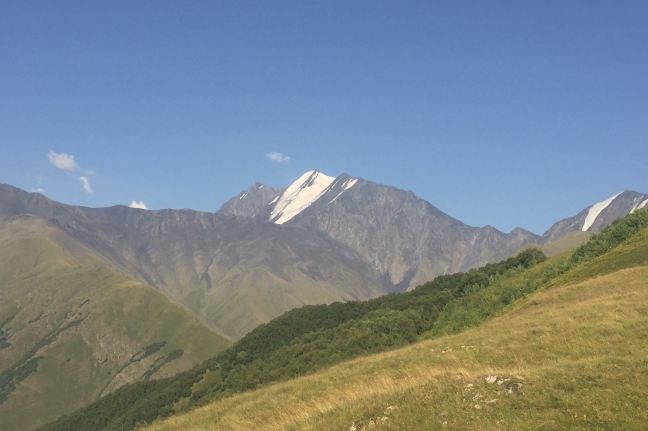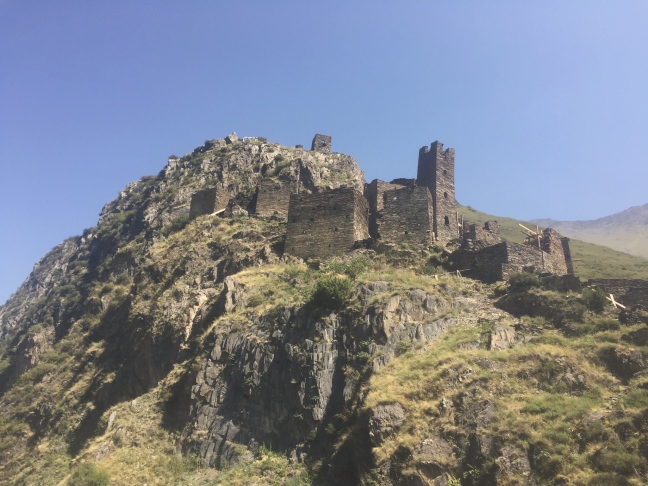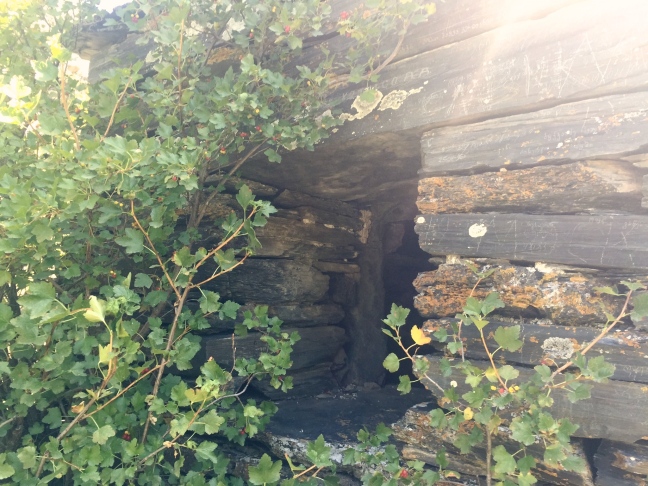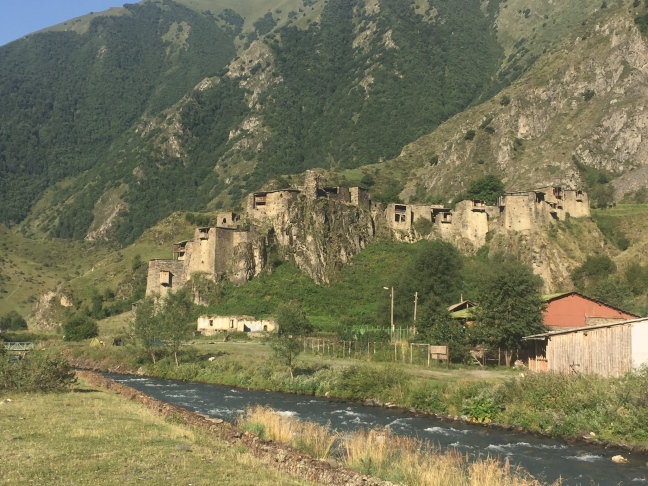
The idea first sprouted when I read a quick reference to a five-day walk through Georgia’s rugged border country next to Chechnya. I badly wanted to travel this route, perhaps on horseback, and savour the remote mountain-tops.
My initial attempt to organise this drew a blank. My guide book said the Tusheti visitor centre just outside Omalo could help set up guides and horses. Well, on the day I dropped by it couldn’t provide even a scrap of information.
As usual, a more serendipitous approach was needed. The day after we came back to Omalo from Dartlo, Rachel and I walked to Shenaqo, a sleepy village a few kilometres east on the other side of a forested canyon. We hiked along a track heavy with the scent of heat, dust and pine.
On our return to Omalo we repaired to a shop cum cafe. The owner, Eteri Markhvaidze, spoke Russian. Rachel also has good Russian and thanks to her we quickly had a conversation going on how I could do the trek. Eteri knew a man who could be my guide.
She took out her calculator and did the sums. I agreed to pay 50 lari (nearly $22) a day to the guide for six days of hire – a four-day ride to the destination, the village of Shatili, and the guide’s two-day ride back. On the same basis I hired two horses at 35 lari (about $15.20) per horse per day. I also hired a tent. The guide, a lean 18-year-old named Lasha Arshaulidze, joined us and said he could start the next day.
I bought food for the journey from Eteri – two kinds of bread, tinned fish, gherkins, cheese, Snickers bars and bottled water.
The next morning Rachel climbed on board a 4 x 4 on the first stage of her journey home and I met up with Lasha. He vaulted onto his horse with the agility of an Olympic gymnast. I had struggled onto mine with the nimbleness of a Chelsea pensioner and I felt a pang of jealousy.

I was on a nine-year-old chestnut mare of Caucasus stock named Luna. For the next four days she would be the most important being in my life. Lasha’s nameless mare was accompanied by a foal, so we were quite an expedition.
For the second time I covered the ground to Dartlo and on arrival had mild intimations of Groundhog Day – it was shearing day again. We passed Dartlo without stopping.
Lasha and I had agreed to communicate in Russian, since he had next to no English. But mid-afternoon he revealed his knowledge of one of the most important words in the English language. “Lunch,” he said. And so we lunched. This was our deepest exchange in English.
We rode past the villages of Chesho and Parsma before we reached Girevi, the literal end of the road and our halt for the night. Just beyond the village a Tushetian stone tower stood tall, giving gravitas to the place.
We slept in our tents and the Caucasus night was mild, warmer than Wales when I camped there in July.
Before we set out on day two I presented my passport at Girevi’s border police post, an establishment with its own hens. I received a permit to travel to Shatili and off we went, heading northwest into mountains empty of human settlement.
The path soon became challenging. It rose quickly and before I knew it we were hundreds of metres up a mountainside. To our left was a precipitous drop to the river below. The path was in poor condition, narrow and strewn with loose slivers of stone. Luna was proving herself to be a sure-footed steed, but I still had moments of terror just contemplating where I was and how dependent I was on my horse. One misstep by Luna and neither of us was likely to survive.
By way of welcome diversion we rode through the abandoned village of Chontio, with stone houses on either side now falling down. Deserted villages prompt questions. Why on earth did people build on this remote spot? What did they do in the evenings? Was the death of the village swift or lingering?
We were not always on horseback. On the most difficult sections we dismounted. Sometimes the path ran all the way down to the river, but the predominant story of the day was threading our way high above tumbling waters on the slenderest of paths.
We camped the night at the Kwachidi bivouac site on the valley floor. Here I could gauge how popular this route has become. There were seven tents with walkers by early evening and then 12 saddled horses rode in from the east with just four riders, Georgians apparently on a mission to pick up tourists or their gear.
Next morning I talked to one of the hikers, a young Englishman with a stout stick setting out to walk the path we had taken the previous day. He introduced himself as David Hirtenstein from Oxford and said that he was walking to India. He had set out from Italy in October 2013 and expected to reach India in a few years.
He was trying to travel without money. “So how does that work?” I asked. “I just don’t worry,” replied David, who has a blog at atasteofancientroutes.wordpress.com
On day three we climbed to the Atsunta Pass, 3,431 metres high. It was a hot, sticky ascent, sometimes on horseback, sometimes on foot, and the latter stages were through a lunar landscape of rocks and scree.
After the pass we had a steep scramble down by foot and soon we were back in a greener world. We rode on a mountainside covered with stumpy rhododendron bushes and a steep drop down to the right. I tried out David’s mantra – I just don’t worry.

We emerged onto a grassy plateau with 360-degree views of the Caucasus, with the snow-capped Mount Tebulos, part of the Chechnya border range, off to our right. Two hawks hovered just ahead of us and one after another dived for prey. I felt part of the landscape, completely at one with the world around me. At the same time it was the closest to heaven I have been on this earth.
We camped the night at the Khidotani police border post.
On the final morning I received my marching orders from Lasha. “One hour on foot,” he said. This sounded ominous and I braced for the worst. But in the event there were no yawning chasms this time, just a rather steep descent. We led our horses down through a lovely deciduous woodland with a variety of flowers, some overhanging the path.
We reached the valley bottom and were back in the land of jeep tracks and human settlement. We rode on a track following a stream and came to Khonischala, with neat vegetable patches and solar energy. It was the first village we had seen since leaving Girevi two days earlier.
As we rode through, three young women each with a tin bucket crossed the road in front of us. This kind of image is so sharp when you have been away from humankind.

A few kilometres further we came to Mutso, a deserted old village on a pinnacle of rock. I climbed up and gazed into a stone crypt where during outbreaks of plague the soon-to-be-dead came to live out their last days or hours. You can still see human bones inside. Georgians know that Mutso is no ordinary place and renovation work began here last year.

We rode on to more stone crypts with human remains set above a gorge at a place called Anatori. From here a Russian flag is visible a few hundred metres away. During these latest Caucasus travels I met the military attaché of an EU member state and he asserted that the flag was flying on Georgian soil.
In late afternoon, after riding about 90 km in all, we rounded a bend and there was Shatili, a magnificent collection of inter-linked stone towers built between the seventh and 13th centuries on a rocky hill. People moved out of them in the second half of the 20th century and most are now empty. A small new village has been built right next door, powered by electricity from a hydro plant on the Argun river.
Over a beer in the evening, Lasha told me that neither Luna nor his horse had ever travelled on the path to Shatili before. He was probably right not to have troubled me with that detail earlier.
Shatili is in the region called Khevsureti. According to Georgia’s official tourism literature, the men in Khevsureti wore chain mail armour and carried swords and shields right up to the 1930s. Georgia has certainly marched to its own drum!
A little book called Caucasian Paths: Khevsureti has provided me with more insights into the ways of old Khevsureti. It says that up to the middle of the 20th century the region had a sexual custom called stsorproba. A young unmarried couple were allowed to lie together during the night, but caresses below the waist were forbidden and a sword was placed between them. What is this Khevsur thing about swords?
During my visit to Shatili my one encounter with local culture was an outdoor concert of Khevsuretian music. On a stage in front of the old town, a four-woman group in traditional attire sang and played on string instruments and drums. The music had a strong emotional charge and often a tinge of sadness, but it was vibrant and good entertainment.

I have now made three trips to the Great Caucasus range in northern Georgia. The learning at a personal level has been that this travelling has done me the world of good. I have breathed the pure air of the mountains, seen extraordinary places and had a sense of living – sometimes quite literally – on the edge. I feel alive to the tips of my fingers.
When I sit in a Tbilisi cafe, I feel blessed that I have seen what French friends would probably call la Géorgie profonde.
I have seen the great mountain ranges that separate Georgia from Russia and watched a Georgian border guard train his binoculars on the giant neighbour to the north. But paradoxically I have a stronger sense now of Georgia’s vulnerability. This watchfulness by the guard is little more than theatre. If the northern neighbours want to play rough they already have forces in South Ossetia, close to the very heartland of Georgia. They also have troops in Armenia to the south.
My crystal ball is dim. Right now things are calm and I have no hesitation in claiming that Omalo to Shatili is one of the great trails of the world. It would be nice, though, if somebody can get round to improving that path.

Stephen
Your blog makes outstanding reading. I join you in a toast to peace!
Jo
LikeLike
Thank you Jo. To peace! A oes heddwch? Heddwch! Stephen
LikeLike
Fantastic adventure and beautiful pictures! I will be soon heading to Georgia and would love to do the same! I wish you the best on your coming adventures.
LikeLike
Hi Kate. Thank you very much for your comments. I wish you good luck with your Georgian travels. It is a country that leaves an indelible impression! All best, Stephen
LikeLike
Hi Stephen!
I wonder if you remember me. I’m from Poland, we met few times in Mestia in June 2015. I dropped by to see what’s new on your blog, I really like your writing style.
Anyway, I have discovered, that you made the trip from Omalo to Shatili, this is what I’m going to do on September this year (but on foot instead of horse). Do you have any advice for me, some tips? 🙂
Best regards,
Wojciech Kulik
LikeLike